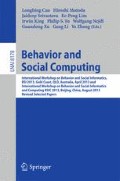Abstract
Twitter is a popular social network service which is continuously growing. Because Twitter has become an efficient platform for advertising companies as a new vast medium, it is obvious that finding influential Twitter users and measuring their influence are important. Intuitively, users who have more followers are likely to be more influential. However, the number of followers does not necessarily mean the confidence of influence. In order to find influential users in Twitter more precisely, in this paper, we present an improvement of PageRank, which we call InterRank (Inter action Rank). It considers not only the follower relationship of the network but also topical similarity between users from tweet context. By using retweet information, we verify that topical similarity indeed affects the influence of a user. Then, we compare InterRank to PageRank with an assumption that influential users are more interactive with their followers. Our comparison results show that the users found by InterRank are more interactive than those by PageRank. Overall, we believe InterRank can be an attractive alternative of PageRank in finding influential users.
Access this chapter
Tax calculation will be finalised at checkout
Purchases are for personal use only
Preview
Unable to display preview. Download preview PDF.
References
Raven, B.H.: Social influence and power. DTIC Document (1964)
Wellman, B., et al.: Computer networks as social networks: Collaborative work, telework, and virtual community. Annual Review of Sociology, 213–238 (1996)
Helm, S.: Viral marketing-establishing customer relationships by ‘word-of-mouse’. Electronic Markets 10(3), 158–161 (2000)
Watts, D.J., Dodds, P.S.: Influentials, networks, and public opinion formation. Journal of Consumer Research 34(4), 441–458 (2007)
Weng, J., et al.: Twitterrank: finding topic-sensitive influential twitterers. ACM (2010)
Cha, M., et al.: Measuring user influence in twitter: The million follower fallacy (2010)
Gruhl, D., et al.: Information diffusion through blogspace. ACM (2004)
Granovetter, M.: Threshold models of collective behavior. American Journal of Sociology, 1420–1443 (1978)
Goldenberg, J., Libai, B., Muller, E.: Talk of the network: A complex systems look at the underlying process of word-of-mouth. Marketing Letters 12(3), 211–223 (2001)
Page, L., et al.: The PageRank citation ranking: Bringing order to the web (1999)
Yamaguchi, Y., Takahashi, T., Amagasa, T., Kitagawa, H.: TURank: Twitter user ranking based on user-tweet graph analysis. In: Chen, L., Triantafillou, P., Suel, T. (eds.) WISE 2010. LNCS, vol. 6488, pp. 240–253. Springer, Heidelberg (2010)
Erkan, G., Radev, D.R.: Lexpagerank: Prestige in multi-document text summarization (2004)
Guo, L., et al.: Analyzing patterns of user content generation in online social networks. ACM (2009)
McPherson, M., Smith-Lovin, L., Cook, J.M.: Birds of a feather: Homophily in social networks. Annual Review of Sociology, 415–444 (2001)
Salton, G., Buckley, C.: Term-weighting approaches in automatic text retrieval. Information Processing & Management 24(5), 513–523 (1988)
Salton, G., McGill, M.J.: Introduction to modern information retrieval (1986)
Zhang, D., Dong, Y.: An efficient algorithm to rank web resources. Computer Networks 33(1), 449–455 (2000)
Author information
Authors and Affiliations
Editor information
Editors and Affiliations
Rights and permissions
Copyright information
© 2013 Springer International Publishing Switzerland
About this paper
Cite this paper
Sung, J., Moon, S., Lee, JG. (2013). The Influence in Twitter: Are They Really Influenced?. In: Cao, L., et al. Behavior and Social Computing. BSIC BSI 2013 2013. Lecture Notes in Computer Science(), vol 8178. Springer, Cham. https://doi.org/10.1007/978-3-319-04048-6_9
Download citation
DOI: https://doi.org/10.1007/978-3-319-04048-6_9
Publisher Name: Springer, Cham
Print ISBN: 978-3-319-04047-9
Online ISBN: 978-3-319-04048-6
eBook Packages: Computer ScienceComputer Science (R0)

